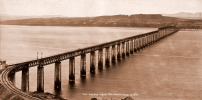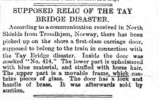matchmaker
Established Member
145 years ago today - 28th December 1879 - the Tay Bridge collapsed in a storm. 75 died and the designer, Sir Thomas Bouch, died in disgrace less than a year later.
On the 28th December 1879, during a ferocious storm, the Tay Bridge collapsed killing 75 passengers and crew.
The cause was never conclusively known, but Thomas Bouch was disgraced and blamed for bad workmanship.
High winds undoubtedly played a part in the disaster that day, but recent research has shown that the cast iron used to join the columns of the bridge together may have become brittle under great strain. It seems that the wrong material was used to build what was the longest railway bridge in the world at the time.
Last edited by a moderator:




